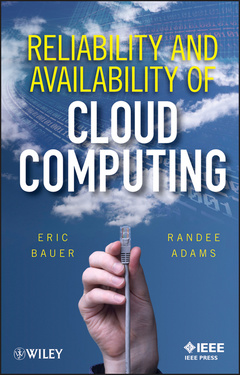Description
Reliability and Availability of Cloud Computing
Author: BAUER Eric
Language: English
Subject for Reliability and Availability of Cloud Computing:
Publication date: 07-2012
Description
/li>Contents
/li>
This book addresses IS/IT architects, developers, program managers, product managers, and quality managers who are considering or responsible for applications that will be virtualized or deployed on a cloud. Topics covered include reliability risks, meeting customer′s expectations, and how to maximize service availability and reliability of virtualized and cloud–based deployments. Working from first principles, this book considers the impact on virtualization and cloud computing in terms of both what design for reliability diligence is most appropriate, and how best to leverage virtualization and cloud to best assure market expectations.
Figures xvii Tables xxi Equations xxiii Introduction xxv I BASICS 1 1 CLOUD COMPUTING 3 1.1 Essential Cloud Characteristics 4 1.2 Common Cloud Characteristics 6 1.3 But What, Exactly, Is Cloud Computing? 7 1.4 Service Models 9 1.5 Cloud Deployment Models 11 1.6 Roles in Cloud Computing 12 1.7 Benefi ts of Cloud Computing 14 1.8 Risks of Cloud Computing 15 2 VIRTUALIZATION 16 2.1 Background 16 2.2 What Is Virtualization? 17 2.3 Server Virtualization 19 2.4 VM Lifecycle 23 2.5 Reliability and Availability Risks of Virtualization 28 3 SERVICE RELIABILITY AND SERVICE AVAILABILITY 29 3.1 Errors and Failures 30 3.2 Eight–Ingredient Framework 31 3.3 Service Availability 34 3.4 Service Reliability 43 3.5 Service Latency 46 3.6 Redundancy and High Availability 50 3.7 High Availability and Disaster Recovery 56 3.8 Streaming Services 58 3.9 Reliability and Availability Risks of Cloud Computing 62 II ANALYSIS 63 4 ANALYZING CLOUD RELIABILITY AND AVAILABILITY 65 4.1 Expectations for Service Reliability and Availability 65 4.2 Risks of Essential Cloud Characteristics 66 4.3 Impacts of Common Cloud Characteristics 70 4.4 Risks of Service Models 72 4.5 IT Service Management and Availability Risks 74 4.6 Outage Risks by Process Area 80 4.7 Failure Detection Considerations 83 4.8 Risks of Deployment Models 87 4.9 Expectations of IaaS Data Centers 87 5 RELIABILITY ANALYSIS OF VIRTUALIZATION 90 5.1 Reliability Analysis Techniques 90 5.2 Reliability Analysis of Virtualization Techniques 95 5.3 Software Failure Rate Analysis 100 5.4 Recovery Models 101 5.5 Application Architecture Strategies 108 5.6 Availability Modeling of Virtualized Recovery Options 110 6 HARDWARE RELIABILITY, VIRTUALIZATION, AND SERVICE AVAILABILITY 116 6.1 Hardware Downtime Expectations 116 6.2 Hardware Failures 117 6.3 Hardware Failure Rate 119 6.4 Hardware Failure Detection 121 6.5 Hardware Failure Containment 122 6.6 Hardware Failure Mitigation 122 6.7 Mitigating Hardware Failures via Virtualization 124 6.8 Virtualized Networks 127 6.9 MTTR of Virtualized Hardware 129 6.10 Discussion 131 7 CAPACITY AND ELASTICITY 132 7.1 System Load Basics 132 7.2 Overload, Service Reliability, and Service Availability 135 7.3 Traditional Capacity Planning 136 7.4 Cloud and Capacity 137 7.5 Managing Online Capacity 144 7.6 Capacity–Related Service Risks 147 7.7 Capacity Management Risks 153 7.8 Security and Service Availability 157 7.9 Architecting for Elastic Growth and Degrowth 162 8 SERVICE ORCHESTRATION ANALYSIS 164 8.1 Service Orchestration Definition 164 8.2 Policy–Based Management 166 8.3 Cloud Management 168 8.4 Service Orchestration’s Role in Risk Mitigation 169 9 GEOGRAPHIC DISTRIBUTION, GEOREDUNDANCY, AND DISASTER RECOVERY 174 9.1 Geographic Distribution versus Georedundancy 175 9.2 Traditional Disaster Recovery 175 9.3 Virtualization and Disaster Recovery 177 9.4 Cloud Computing and Disaster Recovery 178 9.5 Georedundancy Recovery Models 180 9.6 Cloud and Traditional Collateral Benefits of Georedundancy 180 9.7 Discussion 182 III RECOMMENDATIONS 183 10 APPLICATIONS, SOLUTIONS, AND ACCOUNTABILITY 185 10.1 Application Configuration Scenarios 185 10.2 Application Deployment Scenario 187 10.3 System Downtime Budgets 188 10.4 End–to–End Solutions Considerations 197 10.5 Attributability for Service Impairments 201 10.6 Solution Service Measurement 204 10.7 Managing Reliability and Service of Cloud Computing 207 11 RECOMMENDATIONS FOR ARCHITECTING A RELIABLE SYSTEM 209 11.1 Architecting for Virtualization and Cloud 209 11.2 Disaster Recovery 216 11.3 IT Service Management Considerations 217 11.4 Many Distributed Clouds versus Fewer Huge Clouds 224 11.5 Minimizing Hardware–Attributed Downtime 225 11.6 Architectural Optimizations 231 12 DESIGN FOR RELIABILITY OF VIRTUALIZED APPLICATIONS 244 12.1 Design for Reliability 244 12.2 Tailoring DfR for Virtualized Applications 246 12.3 Reliability Requirements 248 12.4 Qualitative Reliability Analysis 256 12.5 Quantitative Reliability Budgeting and Modeling 259 12.6 Robustness Testing 260 12.7 Stability Testing 267 12.8 Field Performance Analysis 268 12.9 Reliability Roadmap 269 12.10 Hardware Reliability 270 13 DESIGN FOR RELIABILITY OF CLOUD SOLUTIONS 271 13.1 Solution Design for Reliability 271 13.2 Solution Scope and Expectations 273 13.3 Reliability Requirements 275 13.4 Solution Modeling and Analysis 279 13.5 Element Reliability Diligence 285 13.6 Solution Testing and Validation 285 13.7 Track and Analyze Field Performance 288 13.8 Other Solution Reliability Diligence Topics 292 14 SUMMARY 296 14.1 Service Reliability and Service Availability 297 14.2 Failure Accountability and Cloud Computing 299 14.3 Factoring Service Downtime 301 14.4 Service Availability Measurement Points 303 14.5 Cloud Capacity and Elasticity Considerations 306 14.6 Maximizing Service Availability 306 14.7 Reliability Diligence 309 14.8 Concluding Remarks 310 Abbreviations 311 References 314 About the Authors 318 Index 319
© 2024 LAVOISIER S.A.S.




